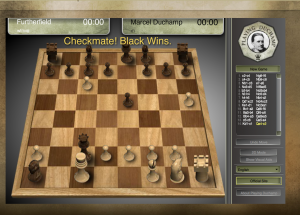Issue 28 11.20.13

Making Duchamp Relevant in the Digital Age
Submitted by Hanna Regev
Playing Duchamp is a net art project and game developed by Scott Kildall, a new media artist whose work often translates between the virtual and the real. In this project, Kildall has programmed a chess computer to play chess as if it were Marcel Duchamp, thus birthing a virtual Duchamp in the form of an AI personality. The question of machine intelligence in game play has become especially relevant with the defeat of chess grandmaster Kasparaov by Deep Blue in 1997. More recently, we have seen IBM’s Watson crush its human opponents in a televised 3-day Jeopardy contest. In his online artwork, Kildall combines new media with the legacy of conceptual art to create digitally coded personality for game play.
Duchamp (1887-1968) was a French painter turned conceptual artist, film maker, chess player, mathematician, composer, and much more. In art circles, Duchamp is remembered for the desertion of retinal art in favor of the mind. This courageous break from established academic conventions in the arts opened the door for radically avant-garde adventures that wreaked havoc in 20th century art world. Duchamp’s foray into the mind gave birth to readymades, paving the way for artists such as Robert Rauschenberg, Jasper Johns, Andy Warhol, and Jeff Koons.
While turning the tables in the art world, Duchamp’s other passion was the game of chess. He was a first-rate chess player and a member of several French teams, participating in Chess Olympiads during the late 1920s and early 1930s. He achieved the rank of Master and, with Vitaly Halberstadt, co-authored a treatise on endgame strategies in chess. By playing chess, Duchamp realized the beauty of the game and that a player’s actions resided in the mind, like conceptual art.
Duchamp once commented that “I am still a victim of chess. It has all the beauty of art—and much more. It cannot be commercialized. Chess is much purer than art in its social position.” Francis Naumann eloquently draws the analogy of Duchamp’s art career to a game of chess in his co-authored book, Marcel Duchamp: The Art of Chess. Naumann even suggests that Etant donnés (the peephole artwork) is likened to the endgame of a chess match.
The connections between Duchamp and new technologies are often overlooked in his biography and discussions of his works. Duchamp was intoxicated by the new technological innovations of his day, such as the discovery of X-rays, electromagnetic energy flowing through bodies and the universe, the creation of the incandescent lamp, the hydraulic generator, the skyscraper, cinema, and the automobile. Some of these remarkable innovations found their way into Duchamp’s popular works such as Nude Descending A Staircase and the Large Glass. He even produced a series of Rotoreliefs, which were optical disks placed on a vertically oriented turntable to produce illusions of motion in perspective.
I recently spoke with Scott Kildall about how he developed Playing Duchamp; his process was a chess game in its own right. Kildall maneuvered different pieces of code: a Flash-based chess interface, custom CGI scripts, and a modified open source chess engine to assemble Playing Duchamp. Kildall also took time to include details such as 3D-rendered chess pieces based on Duchamp’s original hand-carved set. Such work raises a few questions: What is a readymade in new media art? Who owns the invisible lines of the algorithm?
Playing Duchamp is a statement about Duchamp’s place in the art world and the role chess plays in his art. For Duchamp, the game is played out in the mind and the beauty is found in the moves. Chess is likened to performance art combined with abstract thinking. The legendary 20th century artist would have been intrigued by the technology used to create Playing Duchamp and thrilled to reemerge as a specter hovering over chess games that he played over a career spanning 40 years. Kildall’s Playing Duchamp makes Duchamp relevant in the Digital Age and gives him a place in cyberspace by virtual existence.
Other artworks inspired by chess such as Yoko Ono’s White Chess Set and Gabriel Orozco’s Horses Running Endlessly have recast chess as a metaphor for peace, rather than a game of conflict. Like these works, Playing Duchamp asks us to rethink this original war game by dismantling the usual mode of conflict; how can you feel like you “lost” the game when beaten by Marcel Duchamp himself?
Kildall’s Playing Duchamp was unveiled at the 2010 exhibition titled “The Seduction of Duchamp: Bay Area Artists Respond,” which took place at the Los Gatos Museum of Art last fall. Duchamp’s core interests such as science, technology, and chess converged at this exhibit and endowed Duchamp with a virtual presence on the internet, inspiring a debate about the virtues of new media art.
Duchamp remains the king of the art world with no contender in sight. By playing virtually, Kildall challenges us to rethink art’s purpose, the place of new media, and video games within the context of Playing Duchamp and asks us to reevaluate our relationship to the late artist. Are all artists going to be checkmated by the legacy of Duchamp?
The digital code of Playing Duchamp protects the enigmatic artist’s legacy. Marcel Duchamp would have been championing the merits of wireless communication, the world without boundaries, and the digital revolution. It is safe to speculate that he would have been pleased with Kildall’s embrace of new technology and bringing him along to play the game. Though Duchamp passed half a century ago, he remains relevant and powerful. When the art market is driven by investments and speculations, we need to step back, look the possibilities in new media, and ask: What is art’s endgame?
The game can be played at: www.playingduchamp.com
Playing Duchamp was commissioned by Turbulence.org

